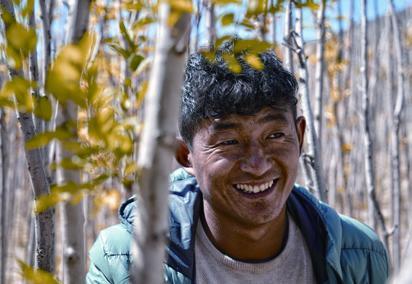Green Gains
By Li Nan
Its March and the temperature is rising in Shannan, Tibet Autonomous Region in southwest China. Its time for planting trees. Farmers are busy leveling their fields, mulching, digging holes and planting saplings. Tashi Palden and his men are among them.

The 27-year-old is president of Axinglang Seedling Nursery in Gonggar County, Shannan, a city 151 km to the southeast of the regional capital Lhasa. Tashi Palden comes from a village in Gyixong Township, which is on the bank of the middle reach of the Yarlung Zangbo River, the longest river in Tibet. Every winter, the river dries up with parts of the riverbed exposed. The sand on the dry riverbed and elsewhere on the land is tossed around by the strong winter wind, creating frequent sandstorms. In the past, the roads connecting Shannan and Lhasa were often buried by sand.
“I dont want to see the crops, the fruit of my parents hard work, ruined by sandstorms, or the worried faces of the villagers. Only by fi xing the sand can we enjoy a calm life in my village,”Tashi Palden told Beijing Review.
Staying the sand
So he began to rent desert land from villagers and established a seedling nursery three years ago. His plan was to plant saplings in the village which would moor the sand to the ground with their roots. It was not an easy job. He used all his savings and in addition had to take a loan of 150,000 yuan ($22,053) from a local agriculture bank. It came at a low interest, thanks to the preferential policies of the county government. Then he began to grow trees such as willows and alamos, but in the beginning, over half of the saplings died.
Still Tashi Palden soldiered on. He underwent training in other nurseries to learn how to increase the saplings survival rate and invited experts to teach his employees. In 2018, 90 percent of the saplings survived and 5,000 of them were sold. In the following year, he enlarged the nursery with more investment.
Besides greening the village and stabilizing the sand, the nursery creates jobs for villagers. From 2017 to 2019, he hired 45 villagers, 60 percent of whom came from impoverished families.

As Tashi Palden puts it, “Planting saplings can turn a wasteland into a land of milk and honey, which both protects the environment and creates jobs for impoverished local resi- dents who cant go to distant places to look for jobs. So why not do it? ”
Protecting the environment has been an effective way for locals to shake off poverty. Since 2001, the Central Government has paid 31.6 billion yuan ($4.5 billion) in ecocompensation to the autonomous region for protecting its forests, grassland, wetland and key ecological reserves, according to the white paper.
According to a Tibet Daily report in early March, reforestation efforts will continue in 2020, with 62,820 hectares of new forests expected. More than 1.24 billion yuan ($178 million) has been set aside for the reforestation and other greening projects. It is estimated that more than 90 percent of rural Tibetans will get jobs in the reforestation projects.
“In 2019, 150,000 people in Tibet cast off poverty and 19 counties were removed from the poverty list. Extreme poverty has been basically eliminated in Tibet,” Qizhala, Chairman of the regional government, said at the third session of the 11th peoples congress of the region on January 7. This year, he added, more followup funds have been earmarked to prevent Tibetans who have risen out of poverty from slipping back into it.

